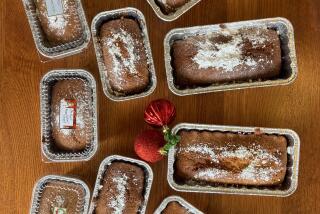VINEGAR : SOUR TALK : THE GOOD STUFF ISN’T JUST SOUR GRAPES. IT’S AN ESSENTIAL FOR GREAT COOKS WHO KNOW THAT THE’S MORE TO VINEGAR THAN VINAIGRETTE. : BEFORE BALSAMIC
- Share via
According to some connoisseurs, it’s the finest vinegar in the world--a dark, intense, complex, mysterious substance, simultaneously nectarous and sharp. Its particular, haunting flavor and aroma are unmistakable. Its uses are many. In its finest, oldest state, it almost seems too good to use on mere salads; at its best, you can practically drink it straight.
Aha! you’re probably thinking. Balsamic vinegar!
Nope. I’m talking about a substance that was once far more famous in this country than the balsamic stuff, and a substance with at least as old a pedigree and at least as many culinary uses. I’m talking about vinagre de Jerez-- Sherry vinegar.
Vinegar is, in effect, sour wine. Its name derives from the French vin aigre , which means exactly that. More specifically, it is wine which has been acetified through contact with a bacterium called acetobacter (or, more specifically, Mycoderma aceti ), which induces further fermentation and thus the formation of acetic and other acids. It is, in effect, wine gone bad--but gone bad in a good way. (Vinegar can be made from liquids that are not grape wine, of course--cider, beer, honey, rice wine, cane syrup, fermented coconut sap, even milk--but that’s another story.)
*
What vinegar is not, or shouldn’t be, is bad wine to begin with. There’s a misguided romantic notion in some quarters that, in traditional European homes, spoiled or oxidized wine is poured into the vinegar barrel to be transmuted into a tart but useful condiment. This is nonsense. Nobody wastes great wine by acetifying it, but good wine is the basis of the best wine vinegars.
And one of the best is certainly vinagre de Jerez. Though this is sometimes made from finished Sherry itself, the classic vinegars of this type are produced by acetifying unfortified wine (i.e., the base wine of Sherry before distilled alcohol is added), specifically that obtained from the first, gentle pressing of the grapes, which is called the yema , or yolk. The grapes in question are almost always of the Palomino variety, whose naturally high sugar levels yield a high-alcohol wine, which in turn produces a vinegar with more residual alcohol than usual, and a higher acetic acid content--thus giving Sherry vinegar a remarkably pungency and enduring finish.
Sherry vinegar gains character and complexity from the means in which it is acetified. Ever since Pasteur discovered the bacterium that induces acetification in 1864, producers of vinegar have been able to control the process, and today there are techniques that can produce usable vinegar in as little as two or three days. Sherry vinegar takes months to acetify, using bacteria that naturally occurs in the wine.
Its real personality, though, comes from the method in which it is aged and blended, basically the same solera system used for Sherry itself. Vinegar aging rooms are filled with rows of 136-gallon used Sherry casks ( botas ) made of porous American oak, which permits the vinegar to “breathe.” The rows are called criaderas or “nurseries,” and they contain vinegars of different ages.
The criadera which holds the oldest one is called the solera , and it is from this that vinegar is usually bottled for sale. The volume extracted is replaced with vinegar from the next oldest; that criadera is then topped up with vinegar from the oldest after that, and so on. Commercial quality Sherry vinegar is about 6 years old on the average, though some producers release older ones, which have aged for 25 years or more--and it is not unknown, in the Sherry country itself, to come upon vinegars dating back a century (though these are almost always reserved for private use by the producers).
*
As well as developing flavors both through oxidation and through contact with the Sherry-saturated oak, Sherry vinegar decreases in alcohol and increases in acetic acid as it ages. At its best and oldest, it grows so rich and enigmatic and vinous that it is almost impossible to tell apart from very fine old Oloroso Sherry--which also loses alcohol during aging, and partially acetifies as well. Even younger examples possess a memorable, almost haunting woody/smoky flavor that adds depth to sauces and dressings and other foods.
Good-quality Sherry vinegar is made by virtually every Sherry bodega , though some keep it mostly for their own use and for gifts. Still, the vinegars of such well-known producers as Sandeman, Lustau, Terry, Sanchez Romate and Gonzalez Byass are sold in this country, as are such brands as La Cosecha (from Bodegas Internacionales), Gran Gusto (from Bodegas Paez Morilla Mendoza) and La Posada (from Jose Estevez). Prices vary, but perfectly good Sherry vinegars can be found for $4 or $5 per 375-milliliter bottle.
Though once used extensively in French cooking, Sherry vinegar has been nearly eclipsed in recent years, even in France, by the Italian aceto balsamico (which, incidentally, is traditionally made by a kind of solera system itself). In Spain, though, it remains an essential ingredient in such classic dishes as gazpacho and escabeche , and has found a place in contemporary Spanish cooking as well. It also dresses up simple salads wonderfully.
*
Gazpacho is often served with chopped tomatoes, onions, sweet peppers and cucumbers on the side as a garnish. Sometimes chopped hard-boiled egg and/or ham are added, but the soup can be served alone.
GAZPACHO ANDALUZ
2 slices French bread, crusts trimmed
5 ripe tomatoes, peeled, seeded and chopped
1 small onion, chopped
1 sweet red pepper, ribs and seeds removed
1 medium cucumber, peeled, seeded and chopped
1/2 cup extra-virgin olive oil
1/4 cup Sherry vinegar
1 teaspoon sweet paprika
1/2 teaspoon hot paprika or cayenne
Salt
Soak bread in bowl with water to cover. Gently squeeze dry. Place bread, tomatoes, onion, red pepper, cucumber, olive oil, vinegar, sweet and hot paprikas and salt to taste in blender or food processor. Process until smooth and thick. Adjust seasonings to taste.
Refrigerate 2 to 3 hours before serving. Makes 4 servings.
Each serving contains about:
348 calories; 192 mg sodium; 1 mg cholesterol; 28 grams fat; 23 grams carbohydrates; 4 grams protein; 1.85 grams fiber.
ESCABECHE OF BONELESS CHICKEN BREASTS
Salt
4 boneless chicken breasts
Mild extra-virgin olive oil
1 onion, thinly sliced
1 cup Sherry vinegar
2 tablespoons whole black peppercorns or mixture of black and white peppercorns
8 whole cloves
3 bay leaves
1 head garlic, separated into cloves
6 to 8 sprigs fresh thyme
1 large sprig fresh rosemary
Parsley, watercress, or shredded lettuce, optional
Salt chicken breasts lightly to taste. In skillet over medium heat, fry chicken in olive oil until light golden brown. Remove from pan. Set aside. Reduce heat to simmer. Slowly cook onion in same skillet in oil until tender and translucent.
Transfer chicken breasts and cooked onion to large pot. Pour in olive oil to cover. Add vinegar, peppercorns, cloves, bay leaves, garlic, thyme and rosemary. Cover pot and bring to boil. Reduce heat to simmer and continue cooking, partially covered, about 45 minutes. Remove pot from heat. Cool to room temperature.
Transfer chicken breasts to glass or earthenware bowl. Remove and discard rosemary and thyme. Pour remaining contents of pot over chicken breasts. If liquid doesn’t completely cover ingredients, add bit more olive oil or transfer contents to smaller bowl.
Cover with plastic wrap. Refrigerate 1 to 2 days. To serve, slice each chicken breast into 1/2-inch pieces and arrange on plate with other ingredients. Moisten lightly with bit of marinade. Garnish with parsley, watercress, or shredded lettuce. Makes 4 servings.
Each serving contains about:
290 calories; 680 mg sodium; 87 mg cholesterol; 15 grams fat; 10 grams carbohydrates; 29 grams protein; 0.41 gram fiber.
LEFTOVER ROAST BEEF OR LAMB SALAD
1 large bunch watercress, trimmed and coarsely chopped
1 small head romaine lettuce, cut in thin strips
3/4 to 1 pound leftover cold roast beef or lamb, very thinly sliced and then cut into thin strips
1/4 cup extra-virgin olive oil
2 teaspoons lemon juice
1 teaspoon aged Sherry vinegar
1/2 cup lightly toasted pine nuts
Salt
Freshly ground pepper
Combine watercress, lettuce and meat in large salad bowl. Add olive oil, lemon juice and vinegar. Toss well. Add pine nuts. Season to taste with salt and pepper. Toss well. Makes 4 servings.
Each serving contains about:
498 calories; 141 mg sodium; 88 mg cholesterol; 42 grams fat; 4 grams carbohydrates; 29 grams protein; 0.57 gram fiber.
More to Read
Eat your way across L.A.
Get our weekly Tasting Notes newsletter for reviews, news and more.
You may occasionally receive promotional content from the Los Angeles Times.







